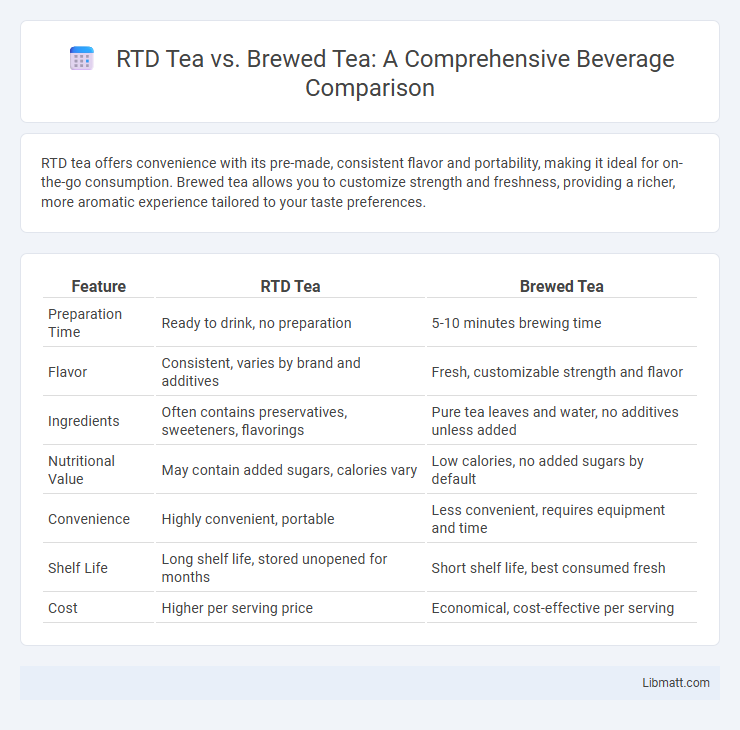RTD tea offers convenience with its pre-made, consistent flavor and portability, making it ideal for on-the-go consumption. Brewed tea allows you to customize strength and freshness, providing a richer, more aromatic experience tailored to your taste preferences.
Table of Comparison
| Feature | RTD Tea | Brewed Tea |
|---|---|---|
| Preparation Time | Ready to drink, no preparation | 5-10 minutes brewing time |
| Flavor | Consistent, varies by brand and additives | Fresh, customizable strength and flavor |
| Ingredients | Often contains preservatives, sweeteners, flavorings | Pure tea leaves and water, no additives unless added |
| Nutritional Value | May contain added sugars, calories vary | Low calories, no added sugars by default |
| Convenience | Highly convenient, portable | Less convenient, requires equipment and time |
| Shelf Life | Long shelf life, stored unopened for months | Short shelf life, best consumed fresh |
| Cost | Higher per serving price | Economical, cost-effective per serving |
Introduction to RTD Tea and Brewed Tea
Ready-to-drink (RTD) tea offers convenience with pre-packaged, chilled beverages available in various flavors and sweetened or unsweetened options, appealing to consumers seeking quick refreshment. Brewed tea, prepared by steeping tea leaves or tea bags in hot water, provides control over flavor intensity, freshness, and customization of additives such as milk, sugar, or lemon. Both RTD and brewed tea cater to distinct preferences, with RTD emphasizing portability and ease, while brewed tea highlights traditional preparation and personalization.
Key Differences Between RTD and Brewed Tea
RTD (Ready-to-Drink) tea is pre-packaged, convenient, and often contains preservatives and sweeteners, whereas brewed tea is freshly steeped from tea leaves or bags, offering greater control over flavor and strength. RTD tea typically has a longer shelf life and consistent taste, while brewed tea allows you to customize temperature and steeping time for a more personalized experience. Your choice depends on convenience versus freshness and flavor flexibility.
Ingredients and Additives Comparison
RTD tea often contains preservatives, sweeteners, and flavor enhancers to maintain shelf life and taste consistency, whereas brewed tea consists primarily of natural tea leaves and water without added chemicals. The additive content in RTD tea can include artificial colors, stabilizers, and sweetening agents like high fructose corn syrup, impacting the overall nutritional profile. Your choice between RTD and brewed tea significantly affects ingredient purity and potential health benefits.
Flavor Profile and Taste Experience
RTD tea offers a consistent, often sweeter flavor profile due to added sugars and preservatives, providing a convenient and refreshing taste experience. Brewed tea delivers a more complex and customizable flavor, allowing you to control steeping time and tea leaves to achieve richer aromas and nuanced bitterness. Your taste preference may depend on whether you prioritize convenience or a deeper, authentic tea experience.
Nutritional Content: What’s Inside Your Tea?
RTD (Ready-to-Drink) tea often contains added sugars, preservatives, and artificial flavors, which can increase calorie content and reduce its natural antioxidant levels compared to freshly brewed tea. Brewed tea retains more polyphenols, catechins, and essential nutrients, offering higher antioxidant benefits and lower calorie counts when consumed without additives. Nutritional differences significantly impact health outcomes, making brewed tea a superior choice for maximizing the natural health benefits of tea leaves.
Convenience and Preparation Time
RTD tea offers unmatched convenience, allowing you to enjoy a ready-to-drink beverage instantly without any preparation. Brewed tea requires steeping leaves or tea bags for several minutes, which can be time-consuming, especially during busy schedules. Your choice hinges on whether you prioritize speed and portability (RTD tea) or a traditional brewing experience.
Cost Analysis: RTD Tea vs Brewed Tea
Ready-to-drink (RTD) tea typically incurs higher unit costs compared to brewed tea due to packaging, convenience, and branding expenses, with prices ranging from $2 to $4 per bottle versus pennies per cup for brewed tea made from loose leaves or tea bags. Brewed tea offers a more economical option for frequent consumers, especially when purchased in bulk, reducing cost per serving significantly. Bulk purchases, energy use for brewing, and time investment remain key factors affecting brewed tea's overall expense, but RTD's premium pricing reflects its portability and immediate consumption benefits.
Environmental Impact of Packaging and Brewing
RTD tea usually comes in single-use plastic or aluminum containers, which contribute significantly to landfill waste and require large amounts of energy for production and recycling. Brewed tea generates minimal packaging waste, especially when using loose leaves or recyclable tea bags, reducing your environmental footprint substantially. The energy used during brewing at home tends to be lower compared to the manufacture and transportation emissions associated with RTD tea packaging.
Health Benefits and Potential Concerns
RTD tea offers convenience and consistent flavor but may contain added sugars or preservatives affecting its health benefits compared to brewed tea. Brewed tea retains more antioxidants like catechins and polyphenols due to minimal processing, supporting heart health and reducing inflammation. Your best choice depends on balancing convenience with a preference for maximizing natural nutrients and minimizing additives.
Choosing the Right Tea for Your Lifestyle
RTD tea offers convenience with pre-made, portable options ideal for busy lifestyles and on-the-go hydration. Brewed tea provides a customizable experience, allowing control over flavor, strength, and freshness, perfect for those who value ritual and personalization. Selecting between RTD and brewed tea depends on balancing convenience with taste preferences and time availability.
RTD tea vs brewed tea Infographic

 libmatt.com
libmatt.com